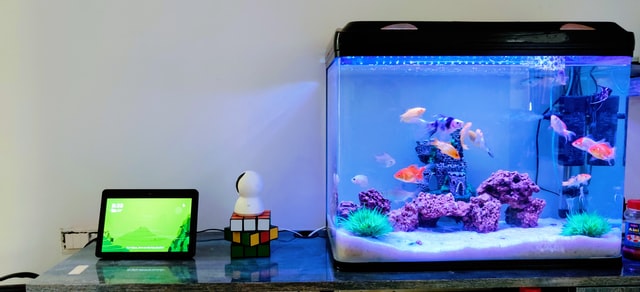There are a few things to consider when creating a perfect environment for fish to flourish. First, the filtration systems installed in fish tanks should be top-notch as they create a clear, clean tank. Filters are broadly categorized as either internal or external filters. Internal filters are some of the best filters for fish tanks. They include under gravel filters and Air-Powered Filters that use an air pump to push water into the tank. Popular external filters include canister filters, wet/dry filters, and power or Hang-On Filters. A canister filter is a pressurized filter placed underneath the fish tank to serve various biological, chemical, and mechanical needs. Other guiding factors to consider when setting up the fish tank include the size of the tank, fish type, budget, and maintenance. Peacock Moss and Marimo moss balls are a highly unique and rare form of algae growth. They can only be found growing in a few lakes throughout the world and are available at Aquarzon.com. Here are 6 tips valuable for setting up a new fish tank:
Create A Working Plan
Begin by creating a progression plan for building a thriving aquarium. One of the key decisions is choosing the fish species. That decision will be guided by the type of tank you choose, for instance, a small species-only tank, breeding tank, or a large community tank. A bigger tank is needed to house more fish, invertebrates, plants, and decorations.
Clean The Tank
With all the equipment assembled, you need to make sure the tank is clean. Use a damp piece of clothing to eliminate dust and debris. For efficient cleaning results, use a new piece of clothing and water bucket. Avoid using soap and detergents because leftover chemicals may get into the water and pollute the ecosystem. If you have settled on a used tank, use vinegar to clean the tank’s interior and exterior surface. Remember to position the tank correctly. It should stand on a solid base to effectively hold the tank and water. An ideal location is an area removed from direct sunlight and power supply.
Add An Appropriate Substrate And Water
The next critical step is preparing the substrate and water. You can let your individual preferences guide your choice of substrate. However, some fish species, such as the catfish, do very well on sandy substrates. The thickness of the substrate should be measured to create a perfect environment for the fish. Experts recommend 1lb of substrate for every gallon of water used. Before adding the substrate, rinse it to eliminate dust and lessen the cloudiness. If you are using powder-coated gravels, use less intense washing to curtail cloudiness. Once the substrate is settled, add water, beginning with freshwater followed by salty water. Also, add a dechlorinator in the ratio of 1ml for every 20 gallons of water.
Choose The Best Aquarium Filter And Media
You can install an internal or external filter in your tank. Ensure the internal filter is placed on the back wall and the power code is connected to the power source. Whether you choose the best canister filter or Hob filter, avoid powering the filter before everything is set up as indicated. External filters often come with a host of media to ensure efficient performance. The filter pulls water outside the tank, cleans it before disembarking. Support media for external filters include thermometers, heaters, air pumps, and lights.
Add Plants And Decorations
Once the tank is operational, add your plants and decorations based on the tank layout. If you want to create a more natural feel, co-opt a few plants, wooden debris, and large stones. Alternatively, consult an aquarium specialist to advise on the type of plants to grow inside the aquarium.
Cycles The Tank And Add Fish
Cycling the tank is a necessary process that should be conducted a few days before adding fish. The Nitrogen Cycle, as it is commonly referred to, helps build an ideal bacteria biosphere around the filter. The filter usually grows a bacteria culture that creates nitrites from ammonia. The nitrites are then induced into nitrates in an elaborate biochemical process. Remember, high nitrites, ammonia, and even nitrates can create a toxic environment for fish, so running the ejection cycle regularly is essential. Also, remember to perform freshwater and saltwater cycling before adding the fish. Depending on the size of your tank, introduce the fish slowly over a few weeks. A slowed acclimatization process is vital in ensuring the tanks’ water temperature and salinity do not cause any harm to the fish.




